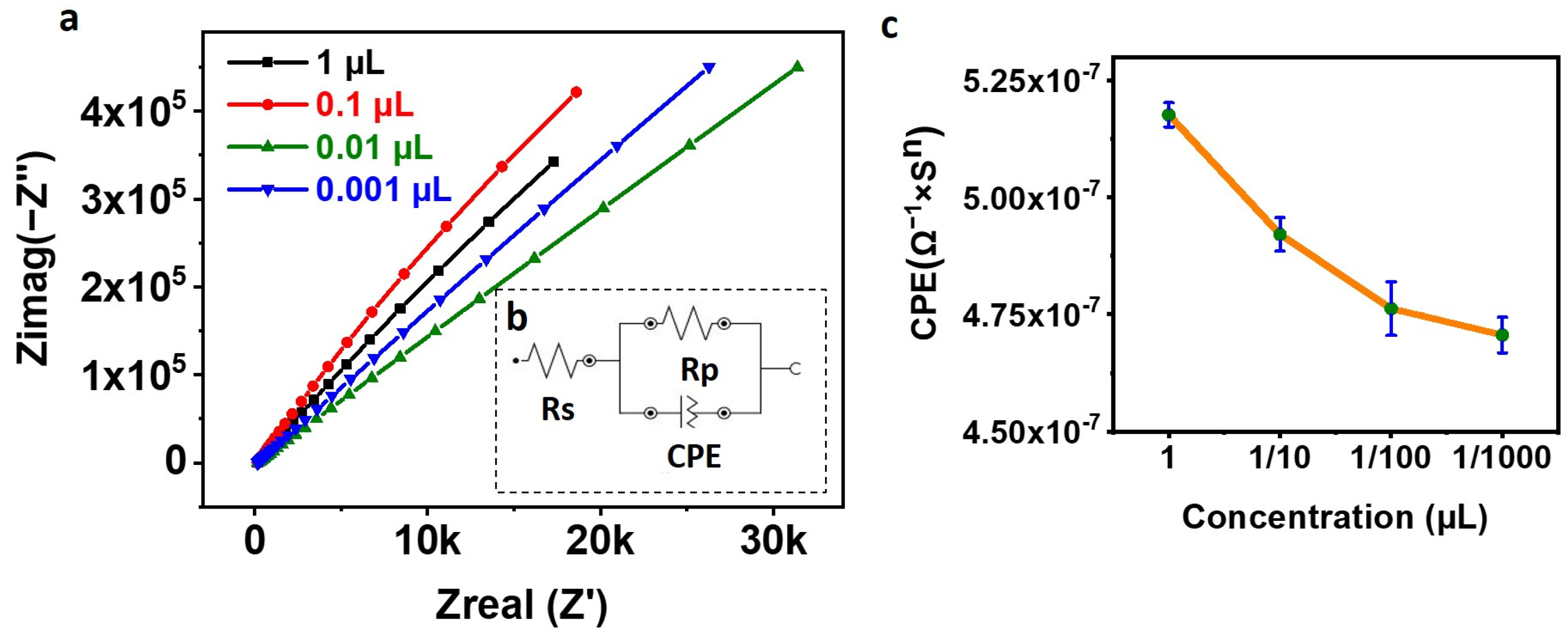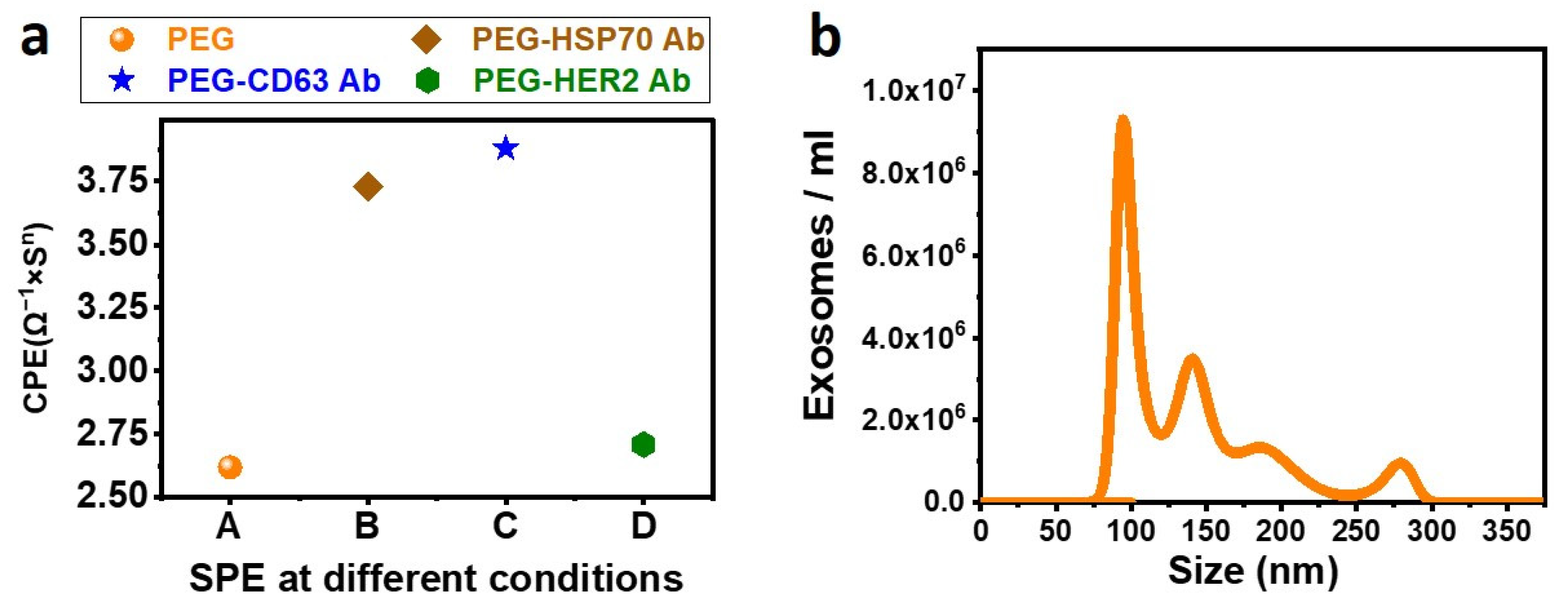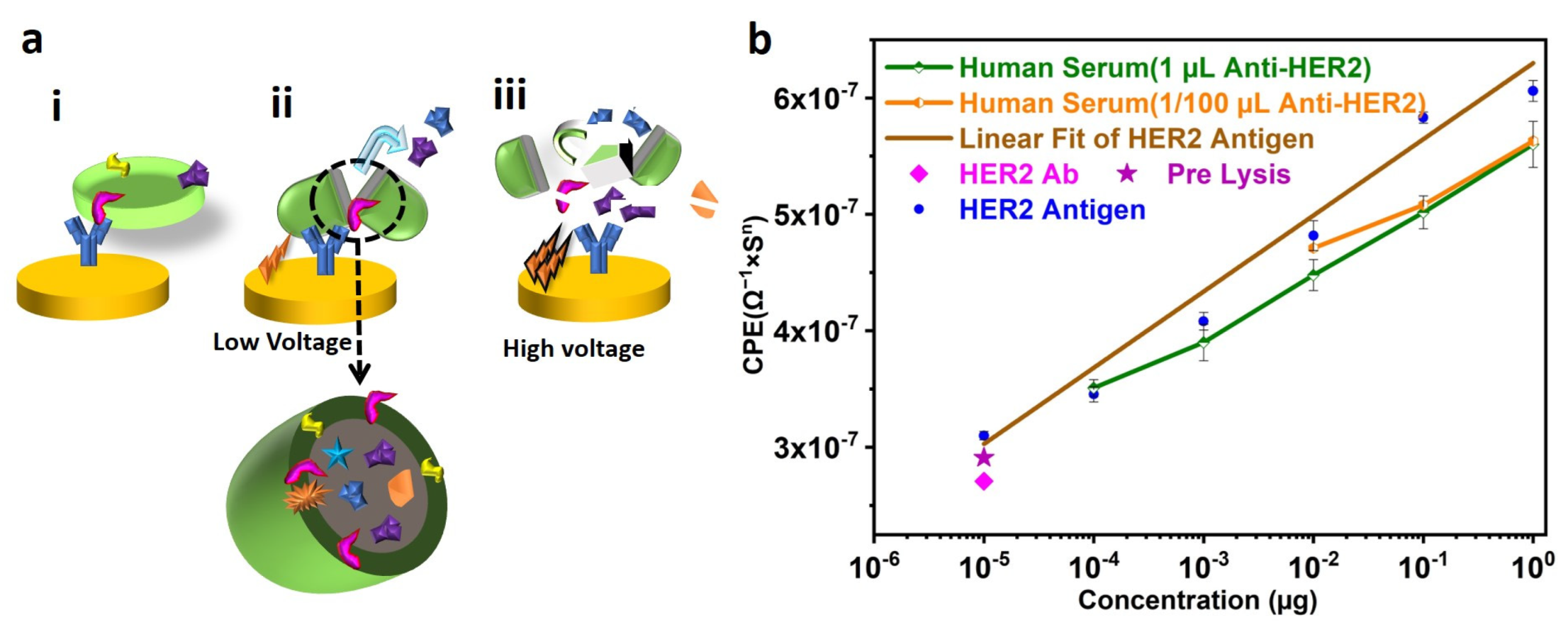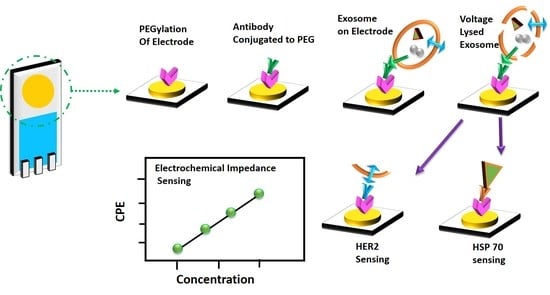Investigating the Electric Field Lysis of Exosomes Immobilized on the Screen-Printed Electrode and Electrochemical Sensing of the Lysed-Exosome-Derived Protein
Abstract
:1. Introduction
2. Materials and Methods
2.1. Materials
2.2. Methods
2.2.1. Immobilizing PEG on the SPE
2.2.2. Functionalization of Antibody on the SPE
2.2.3. Immobilization of Exosomes on the SPE for Isolating the Exosome from Serum
2.2.4. Exosome Lysis and Electrochemical Impedance Spectroscopy (EIS)
2.2.5. Generation of Standard Quantification Curve with HER2
2.2.6. Serum Preparation
2.2.7. Elution of Exosomes from the Surface of the IDE for NTA Quantification
2.2.8. Western Blotting
3. Results
3.1. Optimization of Washing Solution to Prevent Non-Specific Adsorption
3.2. PEGylation of SPE
3.3. Optimization of EDC Concentrations for Activating the COOH of PEG
3.4. Saturation of SPE with Anti-CD63 Antibody for Maximizing the Exosomal Immobilization
3.5. Exosomal Lysis with Sine and Square Waves at Different Voltages and Frequencies
3.6. Western Blotting and EIS of Exosomal Lysate Solutions of Sine Wave
3.7. Quantifying HER2 Protein from Human Serum by Isolating, Electric-Field Lysing, and Sensing
4. Conclusions
Supplementary Materials
Author Contributions
Funding
Institutional Review Board Statement
Informed Consent Statement
Data Availability Statement
Acknowledgments
Conflicts of Interest
References
- Bobrie, A.; Colombo, M.; Krumeich, S.; Raposo, G.; Théry, C. Diverse Subpopulations of Vesicles Secreted by Different Intracellular Mechanisms Are Present in Exosome Preparations Obtained by Differential Ultracentrifugation. J. Extracell. Vesicles 2012, 1, 18397. [Google Scholar] [CrossRef] [PubMed]
- Lamparski, H.G.; Metha-Damani, A.; Yao, J.Y.; Patel, S.; Hsu, D.H.; Ruegg, C.; Le Pecq, J.B. Production and Characterization of Clinical Grade Exosomes Derived from Dendritic Cells. J. Immunol. Methods 2002, 270, 211–226. [Google Scholar] [CrossRef] [PubMed]
- Sitar, S.; Kejžar, A.; Pahovnik, D.; Kogej, K.; Tušek-Žnidarič, M.; Lenassi, M.; Žagar, E. Size Characterization and Quantification of Exosomes by Asymmetrical-Flow Field-Flow Fractionation. Anal. Chem. 2015, 87, 9225–9233. [Google Scholar] [CrossRef] [PubMed]
- Vlassov, A.V.; Magdaleno, S.; Setterquist, R.; Conrad, R. Exosomes: Current Knowledge of Their Composition, Biological Functions, and Diagnostic and Therapeutic Potentials. Biochim. Biophys. Acta (BBA)-Gen. Subj. 2012, 1820, 940–948. [Google Scholar] [CrossRef] [PubMed]
- Filipazzi, P.; Bürdek, M.; Villa, A.; Rivoltini, L.; Huber, V. Recent Advances on the Role of Tumor Exosomes in Immunosuppression and Disease Progression. Semin. Cancer Biol. 2012, 22, 342–349. [Google Scholar] [CrossRef] [PubMed] [Green Version]
- Wendler, F.; Bota-Rabassedas, N.; Franch-Marro, X. Cancer Becomes Wasteful: Emerging Roles of Exosomes in Cell-Fate Determination. J. Extracell. Vesicles 2013, 2, 22390. [Google Scholar] [CrossRef] [Green Version]
- Zhang, H.G.; Zhuang, X.; Sun, D.; Liu, Y.; Xiang, X.; Grizzle, W.E. Exosomes and Immune Surveillance of Neoplastic Lesions: A Review. Biotech. Histochem. 2012, 87, 161–168. [Google Scholar] [CrossRef]
- Li, W.; Li, C.; Zhou, T.; Liu, X.; Liu, X.; Li, X.; Chen, D. Role of Exosomal Proteins in Cancer Diagnosis. Mol. Cancer 2017, 16, 145. [Google Scholar] [CrossRef] [Green Version]
- Isola, A.; Chen, S. Exosomes: The Messengers of Health and Disease. Curr. Neuropharmacol. 2016, 15, 157–165. [Google Scholar] [CrossRef] [Green Version]
- Manna, I.; de Benedittis, S.; Quattrone, A.; Maisano, D.; Iaccino, E.; Quattrone, A. Exosomal MiRNAs as Potential Diagnostic Biomarkers in Alzheimer’s Disease. Pharmaceuticals 2020, 13, 243. [Google Scholar] [CrossRef]
- Guru, K.T.P.; Sreeja, J.S.; Dharmapal, D.; Sengupta, S.; Basu, P.K. Novel Gold Nanoparticle-Based Quick Small-Exosome Isolation Technique from Serum Sample at a Low Centrifugal Force. Nanomaterials 2022, 12, 1660. [Google Scholar] [CrossRef] [PubMed]
- Im, H.; Lee, K.; Lee, H.; Castro, C.M.; Weissleder, R. Novel nanosensing technologies for exosome detection and profiling. Lab Chip 2017, 17, 2892–2898. [Google Scholar] [CrossRef] [PubMed]
- Saha, N.; Brunetti, G.; Kumar, A.; Armenise, M.N.; Ciminelli, C. Highly Sensitive Refractive Index Sensor Based on Polymer Bragg Grating: A Case Study on Extracellular Vesicles Detection. Biosensors 2022, 12, 415. [Google Scholar] [CrossRef] [PubMed]
- Li, S.; Ma, Q. Electrochemical Nano-Sensing Interface for Exosomes Analysis and Cancer Diagnosis. Biosens. Bioelectron. 2022, 214, 114554. [Google Scholar] [CrossRef]
- Yadav, S.; Boriachek, K.; Islam, M.N.; Lobb, R.; Möller, A.; Hill, M.M.; Hossain, M.S.A.; Nguyen, N.T.; Shiddiky, M.J.A. An Electrochemical Method for the Detection of Disease-Specific Exosomes. ChemElectroChem 2017, 4, 967–971. [Google Scholar] [CrossRef]
- Osteikoetxea, X.; Sódar, B.; Németh, A.; Szabó-Taylor, K.; Pálóczi, K.; Vukman, K.V.; Tamási, V.; Balogh, A.; Kittel, Á.; Pállinger, É.; et al. Differential Detergent Sensitivity of Extracellular Vesicle Subpopulations. Org. Biomol. Chem. 2015, 13, 9775–9782. [Google Scholar] [CrossRef]
- Lo, Y.J.; Lei, U. A Continuous Flow-through Microfluidic Device for Electrical Lysis of Cells. Micromachines 2019, 10, 247. [Google Scholar] [CrossRef] [Green Version]
- Zhan, Z.; Li, Y.; Zhao, Y.; Zhang, H.; Wang, Z.; Fu, B.; Li, W.J. A review of electrochemical sensors for the detection of glycated hemoglobin. Biosensors 2022, 12, 221. [Google Scholar] [CrossRef]
- Krishnan, S. Review—Electrochemical Sensors for Large and Small Molecules in Biofluids. J. Electrochem. Soc. 2020, 167, 167505. [Google Scholar] [CrossRef]
- Ramachandran, R.; Chen, T.-W.; Chen, S.-M.; Baskar, T.; Kannan, R.; Elumalai, P.; Raja, P.; Jeyapragasam, T.; Dinakaranh, K.; Kumar, G.P.G. A review of the advanced developments of electrochemical sensors for the detection of toxic and bioactive molecules. Inorg. Chem. Front. 2019, 6, 3418–3439. [Google Scholar] [CrossRef]
- Díaz-González, M.; Hernández-Santos, D.; González-García, M.B.; Costa-García, A. Development of an Immunosensor for the Determination of Rabbit IgG Using Streptavidin Modified Screen-Printed Carbon Electrodes. Talanta 2005, 65, 565–573. [Google Scholar] [CrossRef] [PubMed]
- Pemberton, R.M.; Mottram, T.T.; Hart, J.P. Development of a Screen-Printed Carbon Electrochemical Immunosensor for Picomolar Concentrations of Estradiol in Human Serum Extracts. J. Biochem. Biophys. Methods 2005, 63, 201–212. [Google Scholar] [CrossRef] [PubMed]
- Aguilar, Z.P.; Vandaveer IV, W.R.; Fritsch, I. Self-Contained Microelectrochemical Immunoassay for Small Volumes Using Mouse IgG as a Model System. Anal. Chem. 2002, 74, 3321–3329. [Google Scholar] [CrossRef]
- Wilson, M.S.; Rauh, R.D. Hydroquinone Diphosphate: An Alkaline Phosphatase Substrate That Does Not Produce Electrode Fouling in Electrochemical Immunoassays. Biosens. Bioelectron. 2004, 20, 276–283. [Google Scholar] [CrossRef]
- Panneer Selvam, A.; Vattipalli, K.M.; Prasad, S. Design of a High Sensitive Non-Faradaic Impedimetric Sensor. In Proceedings of the 2012 Annual International Conference of the IEEE Engineering in Medicine and Biology Society, EMBS, San Diego, CA, USA, 28 August–1 September 2012; pp. 3251–3254. [Google Scholar] [CrossRef] [Green Version]
- Song, N.; Xie, P.; Shen, W.; Oh, H.; Zhang, Y.; Vitale, F.; Javanmard, M.; Allen, M.G. A Microwell-Based Impedance Sensor on an Insertable Microneedle for Real-Time in Vivo Cytokine Detection. Microsystems Nanoeng. 2021, 7, 96. [Google Scholar] [CrossRef]
- Alsabbagh, K.; Hornung, T.; Voigt, A.; Sadir, S.; Rajabi, T.; Länge, K. Microfluidic Impedance Biosensor Chips Using Sensing Layers Based on DNA-Based Self-Assembled Monolayers for Label-Free Detection of Proteins. Biosensors 2021, 11, 80. [Google Scholar] [CrossRef]
- Tanak, A.S.; Jagannath, B.; Tamrakar, Y.; Muthukumar, S.; Prasad, S. Non-Faradaic Electrochemical Impedimetric Profiling of Procalcitonin and C-Reactive Protein as a Dual Marker Biosensor for Early Sepsis Detection. Anal. Chim. Acta X 2019, 3, 100029. [Google Scholar] [CrossRef]
- Daniels, J.S.; Pourmand, N. Label-Free Impedance Biosensors: Opportunities and Challenges. Electroanalysis 2007, 19, 1239–1257. [Google Scholar] [CrossRef] [PubMed]
- Magar, H.S.; Hassan, R.Y.A.; Mulchandani, A. Electrochemical Impedance Spectroscopy (Eis): Principles, Construction, and Biosensing Applications. Sensors 2021, 21, 6578. [Google Scholar] [CrossRef]
- Bertok, T.; Lorencova, L.; Chocholova, E.; Jane, E.; Vikartovska, A.; Kasak, P.; Tkac, J. Electrochemical Impedance Spectroscopy Based Biosensors: Mechanistic Principles, Analytical Examples and Challenges towards Commercialization for Assays of Protein Cancer Biomarkers. ChemElectroChem 2019, 6, 989–1003. [Google Scholar] [CrossRef] [Green Version]
- Lisdat, F.; Schäfer, D. The Use of Electrochemical Impedance Spectroscopy for Biosensing. Anal. Bioanal. Chem. 2008, 391, 1555–1567. [Google Scholar] [CrossRef] [PubMed]
- Nemeir, I.A.; Mouawad, L.; Saab, J.; Hleihel, W.; Errachid, A.; Zine, N. Electrochemical Impedance Spectroscopy Characterization of Label-Free Biosensors for the Detection of HER2 in Saliva. Proceedings 2020, 60, 17. [Google Scholar] [CrossRef]
- Qureshi, A.; Gurbuz, Y.; Niazi, J.H. Label-Free Capacitance Based Aptasensor Platform for the Detection of HER2/ErbB2 Cancer Biomarker in Serum. Sens. Actuators B Chem. 2015, 220, 1145–1151. [Google Scholar] [CrossRef]
- Love, J.C.; Estroff, L.A.; Kriebel, J.K.; Nuzzo, R.G.; Whitesides, G.M. Self-Assembled Monolayers of Thiolates on Metals as a Form of Nanotechnology. Chem. Rev. 2005, 105, 1103–1169. [Google Scholar] [CrossRef]
- Maksymovych, P.; Sorescu, D.C.; Yates, J.T. Methanethiolate Adsorption Site on Au(111): A Combined STM/DFT Study at the Single-Molecule Level. J. Phys. Chem. B 2006, 110, 21161–21167. [Google Scholar] [CrossRef]
- Herrwerth, S.; Rosendahl, T.; Feng, C.; Fick, J.; Eck, W.; Himmelhaus, M.; Dahint, R.; Grunze, M. Covalent Coupling of Antibodies to Self-Assembled Monolayers of Carboxy-Functionalized Poly(Ethylene Glycol): Protein Resistance and Specific Binding of Biomolecules. Langmuir 2003, 19, 1880–1887. [Google Scholar] [CrossRef]
- Unsworth, L.D.; Sheardown, H.; Brash, J.L. Polyethylene Oxide Surfaces of Variable Chain Density by Chemisorption of PEO-Thiol on Gold: Adsorption of Proteins from Plasma Studied by Radiolabelling and Immunoblotting. Biomaterials 2005, 26, 5927–5933. [Google Scholar] [CrossRef]
- Akerström, B.; Brodin, T.; Reis, K.; Björck, L. Protein G: A Powerful Tool for Binding and Detection of Monoclonal and Polyclonal Antibodies. J. Immunol. 1985, 135, 2589–2592. [Google Scholar] [CrossRef]
- Martín-Gracia, B.; Martín-Barreiro, A.; Cuestas-Ayllón, C.; Grazú, V.; Line, A.; Llorente, A.; De La Fuente, J.M.; Moros, M. Nanoparticle-Based Biosensors for Detection of Extracellular Vesicles in Liquid Biopsies. J. Mater. Chem. B 2020, 8, 6710–6738. [Google Scholar] [CrossRef]
- Zacco, E.; Pividori, M.I.; Alegret, S. Electrochemical Biosensing Based on Universal Affinity Biocomposite Platforms. Biosens. Bioelectron. 2006, 21, 1291–1301. [Google Scholar] [CrossRef]
- Tan, L.D.; Xu, Y.Y.; Yu, Y.; Li, X.Q.; Chen, Y.; Feng, Y.M. Serum HER2 Level Measured by Dot Blot: A Valid and Inexpensive Assay for Monitoring Breast Cancer Progression. PLoS ONE 2011, 6, e18764. [Google Scholar] [CrossRef] [PubMed] [Green Version]
- Marques, R.C.B.; Viswanathan, S.; Nouws, H.P.A.; Delerue-Matos, C.; González-García, M.B. Electrochemical Immunosensor for the Analysis of the Breast Cancer Biomarker HER2 ECD. Talanta 2014, 129, 594–599. [Google Scholar] [CrossRef] [PubMed] [Green Version]







| Voltage | Sine Wave | Square Wave | ||||
|---|---|---|---|---|---|---|
| 10 Hz | 500 Hz | 1 KHz | 10 Hz | 500 Hz | 1 KHz | |
| 50 mV | 5.92 × 10−7 | 5.60 × 10−7 | 5.00 × 10−7 | 5.65 × 10−7 | 5.60 × 10−7 | 5.52 × 10−7 |
| 500 mV | 6.69 × 10−7 | 6.27 × 10−7 | 5.72 × 10−7 | 6.53 × 10−7 | 6.32 × 10−7 | 6.22 × 10−7 |
| 2 V | 9.10 × 10−7 | 8.22 × 10−7 | 5.48 × 10−7 | 1.23 × 10−6 | 9.36 × 10−7 | 7.01 × 10−7 |
| Technique | Advantages | Disadvantages | Limit/Range of Detection/Source |
|---|---|---|---|
| Differential Pulse Voltammetry(DPV) [15] | Direct Exosome isolation and sensing on SPE | Labeled Technique, Accurate quantity of HER2 may not be detectable | 4.5 × 105 exosomes. Range: not mentioned. Medium |
| Aptamer-based Non-Faradaic EIS [34] | Label-free. | Aptamers are not easily available compared to Antibodies. | 0.2–2 ng/mL; Serum |
| Sandwich immunoassay using Linear Sweep Voltammetry [43] | Well-known process steps and can be accurate. In this method, HER2 is detected without isolation of exosomes by utilizing HER2 fragments of serum. | Enzyme label is required. Needs two Antibodies for detection. More processing steps. | 15–100 ng/mL; Serum. |
| Electrochemical Impedance Spectroscopy [33] | Does not need blood for detection. Label-free. | Serum levels for HER2 should be greater than 19 ng/mL [43] for breast cancer patients. | 5-40 pg/mL; Saliva |
| Our Technique | Label-Free. HER2 is specific to exosomes. Can be extendable to specifically isolate all types of Extracellular Vesicles, by varying the Antibody on the SPE for immobilization. | A second SPE should be used for detecting the protein derived from exosome lysate. | Linear range: 0.1 ng to 1 µg. Limit of detection: 10 pg. Serum |
Disclaimer/Publisher’s Note: The statements, opinions and data contained in all publications are solely those of the individual author(s) and contributor(s) and not of MDPI and/or the editor(s). MDPI and/or the editor(s) disclaim responsibility for any injury to people or property resulting from any ideas, methods, instructions or products referred to in the content. |
© 2023 by the authors. Licensee MDPI, Basel, Switzerland. This article is an open access article distributed under the terms and conditions of the Creative Commons Attribution (CC BY) license (https://creativecommons.org/licenses/by/4.0/).
Share and Cite
Pammi Guru, K.T.; Praween, N.; Basu, P.K. Investigating the Electric Field Lysis of Exosomes Immobilized on the Screen-Printed Electrode and Electrochemical Sensing of the Lysed-Exosome-Derived Protein. Biosensors 2023, 13, 323. https://doi.org/10.3390/bios13030323
Pammi Guru KT, Praween N, Basu PK. Investigating the Electric Field Lysis of Exosomes Immobilized on the Screen-Printed Electrode and Electrochemical Sensing of the Lysed-Exosome-Derived Protein. Biosensors. 2023; 13(3):323. https://doi.org/10.3390/bios13030323
Chicago/Turabian StylePammi Guru, Krishna Thej, Nusrat Praween, and Palash Kumar Basu. 2023. "Investigating the Electric Field Lysis of Exosomes Immobilized on the Screen-Printed Electrode and Electrochemical Sensing of the Lysed-Exosome-Derived Protein" Biosensors 13, no. 3: 323. https://doi.org/10.3390/bios13030323





